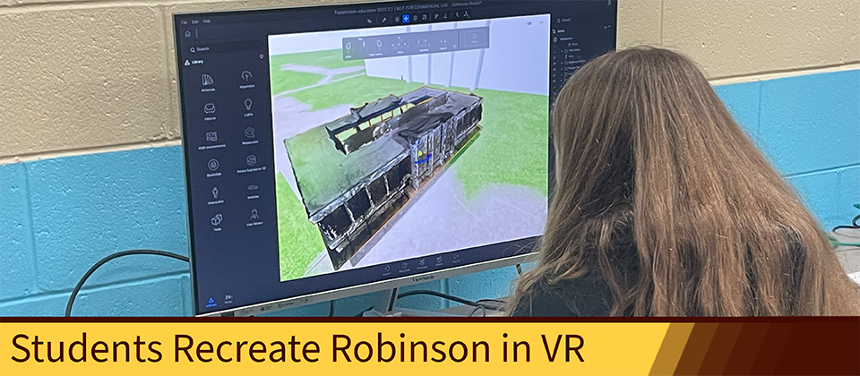Students Recreate Robinson in VR
Students Recreate Robinson in VR
Students Recreate Robinson in VR
The role of a programmer doesn't fit into one box. The variety computer science offers is just as wide as its theory is deep. Computer science can take you anywhere and everywhere, including the great outdoors. Masters students Anthony Marinelli and Mary Moor experience just that with their senior project—recreating Rowan in virtual reality!
Marinelli and Moor developed a 3D model of Robinson Hall and the surrounding areas by scanning the terrain via drone. They used that data to create the 3D model. They next made the model tourable, so you could walk around Robinson Square virtually. “We wanted to give people the ability to explore Rowan in 3D slightly differently than a static tour on a computer,” says Moor.
Project inspiration came from multiple sources. Marinelli and Moor are both part of the Rowan Association of Computing Machinery (ACM) chapter. The chapter visited Cesium last fall, a geospatial software company. “We started thinking, woah, we could make 3D models of Rowan University,” says Marinelli. “But at the time, it would've been a very big undertaking and impossible for us to do, but the tech rapidly progressed in the span of a few short months, so the project became doable,” says Marinelli. For Moor, further inspiration grew from her coursework with Professor Rabbitz, who teaches computer graphics. Moor had even more experience with graphic design through her participation in the ACM 2023 Fall Game Jam, where she made 3D models for her team’s video game.
The project wasn’t all smooth sailing, as the duo encountered several issues. At the start of the semester, the ARVR lab hadn’t been completely finished, so Marinelli and Moor had to personally assist in equipment set up. On top of that, they needed permission from campus security every time they wanted to fly the drone. “More than anything else,” Marinelli adds, “it was pioneering this new tech. It’s all new, so there’s really not a lot of resources to go off of.”
“The software we use for modeling, like TwinMotion and Unreal, kept updating,” says Moor. “We had to keep relearning the tech on a tight schedule.” Despite the numerous issues, the two greatly enjoyed the opportunity to do something new with programming. “It’s really magical watching the models load in, and everything is just there and works,” says Marinelli.
“It’s also been really cool flying the drone around,” says Moor. “I feel like I’m doing real field work instead of getting carpal tunnel in a dark lab,” she continued.
An unsung hero of their work was Professor Rabbitz, who guided the students through the project. “I really enjoyed going out with the students and scanning buildings with the drone, and actually experiencing what they’re building in VR using our department’s VR lab,” says Rabbitz.
“[Rabbitz] was a huge help. He knows what he's talking about and if we have questions he doesn't know, he has people we can contact to get answers—or at least point us in the right direction,” says Marinelli.
So, what’s next for the project? “Our original idea was to incorporate Rowan’s 10 year master renovation & construction plan and build onto them, but we never got the blueprint for what they’re trying. At a later date we could use the blueprints and create a 3D model,” says Moor. But for now, as the fall semester marches on, both students are focused on bringing just Robinson alive—within the comfort of building itself.
Written by Kiley Parker | Posted 10.11.24
